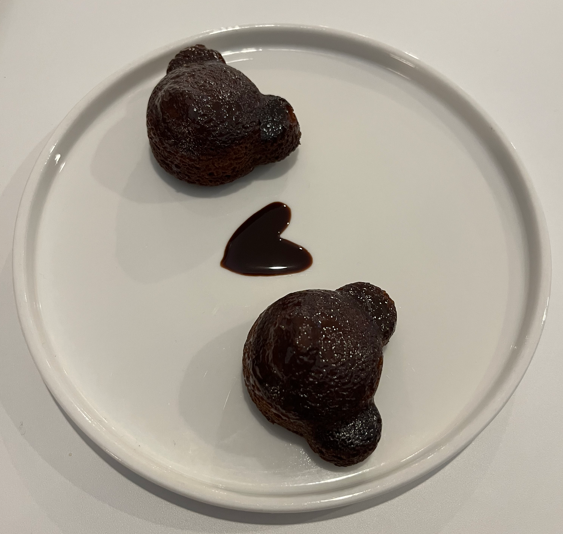| 일 | 월 | 화 | 수 | 목 | 금 | 토 |
|---|---|---|---|---|---|---|
| 1 | 2 | 3 | 4 | |||
| 5 | 6 | 7 | 8 | 9 | 10 | 11 |
| 12 | 13 | 14 | 15 | 16 | 17 | 18 |
| 19 | 20 | 21 | 22 | 23 | 24 | 25 |
| 26 | 27 | 28 | 29 | 30 | 31 |
- binary tree
- 리트코드
- 우선순위 큐
- 깊이우선탐색
- dfs
- two pointers
- Java
- 재귀함수
- 브루트포스
- Algorithm
- coding
- PCCP
- leetcode
- ArrayList
- recursion
- hashset
- programmers
- HashMap
- 알고리즘
- string
- greedy
- priority queue
- Array
- 부분배열
- DP
- Today
- Total
지식창고
[Java] LeetCode 1402. Reducing Dishes 본문
[Java] LeetCode 1402. Reducing Dishes
문 제 :
n개의 만족도 배열 satisfaction 배열이 주어진다.
쉐프는 한 번에 하나씩의 요리를 할 수 있다.
요리를 할 때마다 Like-time의 계수가 1부터 +1씩 증가한다.
요리의 만족도는 Like-time의 계수 * satisfaction[i] 이다.
쉐프는 원하는 요리 (satisfaction[i])만 할 수 있다.
요리의 만족도를 가장 크게 만들면 몇 인가?
Constraint
{ n == satisfaction.length }
{ 1 <= n <= 500 }
{ -1000 <= satisfaction[i] <= 1000 }
Matter
A chef has collected data on the satisfaction level of his n dishes. Chef can cook any dish in 1 unit of time.
Like-time coefficient of a dish is defined as the time taken to cook that dish including previous dishes multiplied by its satisfaction level i.e. time[i] * satisfaction[i].
Return the maximum sum of like-time coefficient that the chef can obtain after dishes preparation.
Dishes can be prepared in any order and the chef can discard some dishes to get this maximum value.
Example )
Input: satisfaction = [-1,-8,0,5,-9]
Output: 14
Explanation:
After Removing the second and last dish, the maximum total like-time coefficient will be equal to (-1*1 + 0*2 + 5*3 = 14).
Each dish is prepared in one unit of time.
=========================================================================
Input: satisfaction = [4,3,2]
Output: 20
Explanation:
Dishes can be prepared in any order, (2*1 + 3*2 + 4*3 = 20)
==========================================================================
Input: satisfaction = [-1,-4,-5]
Output: 0
Explanation:
People do not like the dishes. No dish is prepared.
접 근 :
누적합을 이용한 DP
해 결 & 설 명:
n개의 dp 배열을 선언해준다.
satisfaction 배열을 내림차순으로 정렬해준다. -> int 형태로 reverse 정렬을 못하기 때문에 Integer형으로 변환해서 내림차 정렬을 해준다.
변환한 Integer 배열 : sat[]
가장 큰 만족도를 가진 요리부터 요리 리스트에 추가한다.
요리를 할 때마다 계수가 +1이 되기 때문에 만족도가 양수이면 상승 할 것이고, 음수이면 반대로 하락 할 것이다.
이 점을 이용해 큰 만족도의 요리부터 요리를 시작한다.
요리가 1개일 경우부터, n개까지 경우를 생각한다.
1개 일 경우부터 dp 배열을 초기화 해준다. -> dp[0] = sat[i] * 1
요리가 늘어날 때마다 계수가 증가하기 때문에 dp 식을 구하기 위해 누적합을 구해준다.
dp[i] 구하는 방법 :
이때까지 한 요리들의 계수도 전부 다 +1이 되기 때문에 전체를 한번 더 더해준것과 같다.
여기에 이번에 새롭게 추가된 요리를 더해준것이 누적합이 된다.
예를 들어 3번째 요리를 추가했을 때 dp[3] 구하는 것을 식으로 설명하면 다음과 같다.
dp[3] = (1번째요리 * 3) + (2번째 요리 * 2) + (3번째 추가한 요리 * 1) -> *1은 생략가능이다. 따라서 생략한다.
여기서, 2번째 요리를 추가했을 때의 dp[2]는
dp[2] = (1번째요리 * 2) + 2번째 추가한 요리
가 된다.
따라서 3번째 요리를 추가했을 때 dp[3] 을 다시 정의할 수 있다.
dp[3] = dp[2] + 누적합 + 이번에 추가한 요리
위 식을 활용하여 dp[i]를 이전 것 과 비교해서 큰 것으로 최신화 해간다.그리고 나서 0과 비교하여 (모든 음식을 버렸을 때와 비교) 큰 것을 택한다.
결 과 :
class Solution {
public int maxSatisfaction(int[] satisfaction) {
int res = 0;
int n = satisfaction.length;
int sum=0;
// Collection 형으로 다시 배열 정의
Integer sat[] = Arrays.stream(satisfaction).boxed().toArray(Integer[]::new);
Arrays.sort(sat, Collections.reverseOrder());
int dp[] = new int[n];
dp[0] = sat[0];
sum = sat[0];
for(int i=1; i<n; i++) {
dp[i] = Math.max(dp[i-1], dp[i-1] + sum + sat[i]);
sum += sat[i];
}
res = Math.max(res, dp[n-1]);
return res;
}
}'Algorithm > Leetcode' 카테고리의 다른 글
| [Java] LeetCode 1721. Swapping Nodes in a Linked List (0) | 2023.05.15 |
|---|---|
| [Java] LeetCode 2405. Optimal Partition of String (0) | 2023.04.05 |
| [Java] LeetCode 2316. Count Unreachable Pairs of Nodes in an Undirected Graph (0) | 2023.03.25 |
| [Java] LeetCode 1319. Number of Operations to Make Network Connected (0) | 2023.03.23 |
| [Java] LeetCode 1472. Design Browser History (0) | 2023.03.18 |
